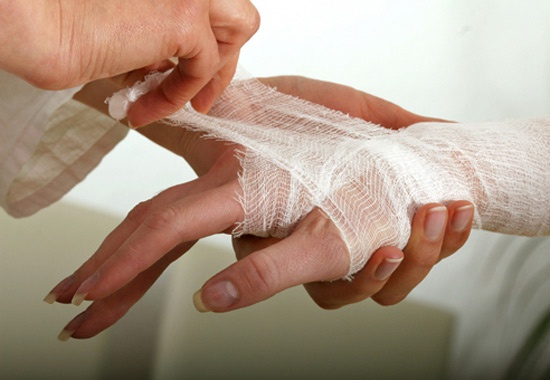You will need
- - the bandage;
- - gauze;
- - surgical gloves;
- - tweezers;
- - scissors;
- - band-aid;
- hydrogen peroxide;
- - solution of potassium permanganate;
- - Vishnevsky ointment.
Instruction
1
Processing and treatment of purulent wounds is aimed at removal of necrotic tissue, drainage of the damaged lesion, suppression of microflora and accelerate the recovery.
2
First, prepare everything you need. You will need gauze, surgical gloves, bandages, adhesive tape, hydrogen peroxide, a pink solution of manganese, Vishnevsky ointment, tweezers and scissors.
3
Make sure that all materials used are sterile. Wash your hands with soap and dry with a disposable towel.
4
Wear gloves and remove the soiled bandages off the festering wounds (if any). If it is stuck, squeeze her the hydrogen peroxide and remove so that not to damage the affected area. Otherwise the wound might start bleeding.
5
Change gloves. With tweezers gently take a sterile gauze pad, wet it with a solution of hydrogen peroxide several times and wipe the area around the damaged section. This is necessary to avoid new bacteria found on the skin.
6
You will then need to treat the wound several times, alternating between hydrogen peroxide and a solution of potassium permanganate. Concluding the process, soak a gauze napkin with ointment Vishnevsky, put on the wound and cover with a dry cloth. You can now wrap the affected area or secure the dressing with a band-aid.
7
Keep in mind that festering wound, do not rinse with water and not covered with powder. Also, you cannot impose on her wool.
8
In most cases, the wounds become infected with pyogenic bacteria, however, is that they penetrate other microbes. The most dangerous of them – the Bacillus of tetanus, which can get into the wound from soil, dust or manure. In these cases developed tetanus, which can lead to death. At the slightest suspicion on him, you should immediately consult a doctor.
9
If the wound is deep and has a larger area after the initial treatment, you must consult a doctor. Treatment of severe festering wounds in many cases requires surgical intervention.
Note
Festering wounds, in order to avoid serious problems should be treated in a timely manner. All purulent inflammation it is necessary to show the therapist or surgeon. But, nevertheless, the control of the attending doctor is still needed. If you decide to start treatment with traditional methods, we in the article "Festering wounds: the treatment of folk ways", we offer a few tried and tested recipes.
Useful advice
An excellent bactericide and blood purifier remedy for suppurating wounds is the juice of wormwood. Healer V. Tarasov recommends for the healing of wounds and cuts on the hand, sprains of tendons, improve blood circulation to tie around the wrist of the red woolen thread. Purulent and infected wounds treated with compresses of a 30% solution of honey in distilled or boiled water at 32 °C (3 times daily).
